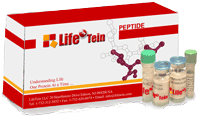 Download as PDF
Download as PDF 
2. A Simple Introduction to Peptide Synthesis
3. Peptides - From Discovery to Therapeutics
Peptides are short polymers formed through the formation of peptide bonds between α-amino acids. The major classes of peptides include ribosomal peptides, non-ribosomal peptides, peptones, and peptide fragments. The hypothalamic peptide hormone gonadotropin-releasing hormone (GnRH) is a ribosomal peptide. This peptide is synthesized by translation of mRNA. GnRH is subjected to a regulatory proteolytic pathway through which it is processed into its mature form. Non-ribosomal peptides are usually produced by bacteria or fungi. Non-ribosomal peptides often have cyclic or branched structures. For example, Bacitracin is a mixture of related cyclic polypeptides produced by organisms of the licheniformis group. Peptones are derived proteins that may be produced by hydrolysis of a native protein with an acid or enzyme. Peptide fragments are pieces of proteins that are used to identify or quantify the source protein.
Peptides play important roles in molecular biology, biochemistry, immunology, and medicine. Synthetic peptides have been widely used for structure-function studies of polypeptides. The processes involved in these studies include initiation and inhibition through protein-protein interaction. In the case of non-formyl peptides such as HP-20, rapid intracellular calcium mobilization of human neutrophils can be measured in order to explore their interactions with the formyl peptide receptor (FPR).
Peptides have several major applications:
- Cosmetics
- Protein structure and function studies: immune monitoring, epitope discovery
- Food and health care applications: antimicrobials
- Therapeutic purposes
- Cell Penetrating Peptides
